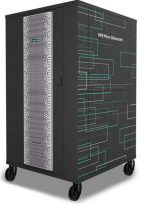Versa Growth Shows SASE Success

Versa Networks' long-term investment in integrated software-defined wide-area networking (SD-WAN) and Secure Access Service Edge (SASE) technologies is paying dividends, as new growth and performance data shows the company having strong growth and customer adoption with a networking portfolio well suited for the work-from-anywhere (WFA) trend.
Versa provides a wide portfolio of virtualized networking and security technologies that can be used to set up and manage enterprise and communications networks using a single, cloud-based platform.
Last month, the company announced a record year for 2020, which saw sales nearly doubling. The company now has hundreds of thousands of sites deployed at enterprises worldwide and thousands of customers. This week, the company released details on customer deployments for its SASE technologies. Versa says customers have realized savings of up to 80% by using a full combined SASE solution. It also claims it has reduced the deployment time to under 12 minutes to set up a branch.
In addition, Versa says it doubled its registered channel partners around the world in 2020, increased its workforce by 25%, and grew to 150 service providers, including seven of the world’s top 10, who have standardized on Versa.
Integrated Portfolio Pays Off
One of Versa's strengths is that it has always favored developing its own integrated security technologies for its SD-WAN and SASE functions, as detailed in our recent SASE report. Versa functions and features include SD-WAN, routing, Next Generation Firewall (NGFW), Secure Web Gateway (SWG), private access, IDS/IPS, CASB, Anti-Virus/Anti-Malware, Role-Based Access Control, and User and Entity Behavior Analytics.
For example Lance Brophy, IT Director of Operations Transformation with Thornton Tomasetti, endorsed the integration of SD-WAN and SASE in a recent company statement.
“There are numerous security vendors on the market that deliver individual components of our SASE strategy. Many of these solutions require proprietary hardware and have different management consoles that add unnecessary complexity and result in added effort for our IT organization to support,” said Brophy. “We were attracted to Versa’s consolidated approach combining SD-WAN with cloud security, next generation firewall, threat management, and role-based access control – all in a single software stack. These products are traditionally packaged separately but Versa gave us the ability to manage different SASE components under one intuitive interface, significantly reducing complexity and costs.”
Amr Eid, CEO and Board Member, OmniClouds, said Versa is playing a role in his organization's need to support WFA applications.
“Implementing SASE to enable remote access, teleworking, remote-education, and work-from-home [WFH] is critical for the growth of OmniClouds, our customers, and our partners this year,” said Eid in a statement. "Versa SASE enabled us to achieve 50% improvement in latency and user experience, as well as improve conferencing for hundreds of our work-from-home users. Most importantly, we have expanded our market share in terms of customers and subscriber base by more than 40x because Versa delivers the high performance and easy management that we were looking for to accelerate our business.”
WFA Plays into Secure Acces
The WFA trend will likely contribute to Versa's continued growth this year. The launch of Versa's Secure Access solution last year was timed well as organizations look for more streamlined ways to support secure, remote networking.
This launch was covered last year by Futuriom in a paper called "Secure Cloud Networking for the WFH Era." With the expansion of WFH and WFA needs, Futuriom analysis found that integrated SD-WAN, VPN, and SASE solutions will meet remote security needs by providing integrated, cloud-based deployment and management.
Versa VP of Marketing Mike Wood said that WFH and WFA is a big focus for Versa in 2021, as organizations look to support access to secure, high performance networks.
"Our customers are seeing a lot of application performance on collaboration apps," said Wood.
















